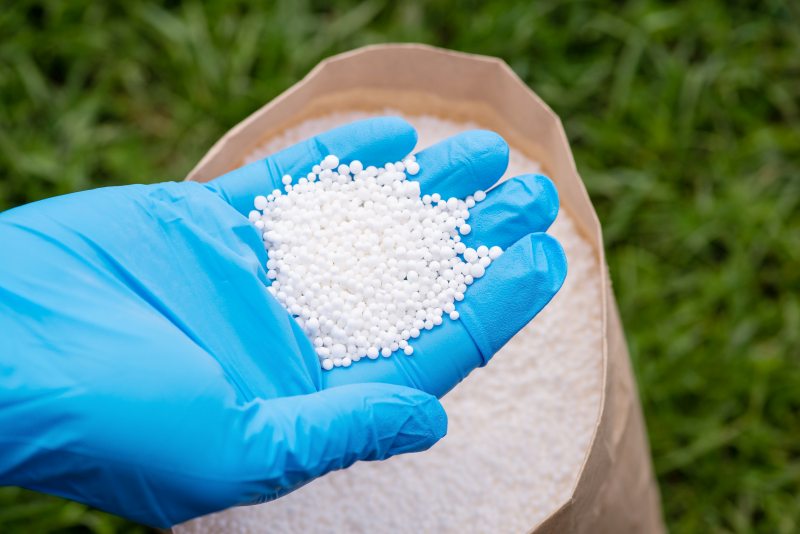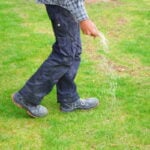
When and how often you fertilize your lawn depends on grass type, lawn goals, and whether a soil test says you need to. Fertilize your lawn at least once or twice per year. If you notice grass yellowing, lawn weeds, or slow grass growth, you may need to fertilize up to four times per year.
Is your lawn made of warm-season grass? Fertilize at least once in late spring through late summer. For cool-season grass, fertilize during the fall.
Some grasses require more frequent fertilization than others. Already know what type of grass you have? Our guides below can help you develop a fertilization schedule for your specific grass type:
- When to Fertilize Fescue
- When to Fertilize Kentucky Bluegrass
- When to Fertilize Centipedegrass
- When to Fertilize Buffalograss
- When to Fertilize Zoysiagrass
- When to Fertilize Bermudagrass
How Often Should You Fertilize Your Lawn?

Generally, established lawns should be fertilized once or twice per year during the turf’s growing season. Advice on fertilizing more than that varies, with some lawn pros suggesting you fertilize three to four times per year and others warning against any more than twice per year, as you can potentially overfertilize and kill your grass.
It’s difficult to establish hard-and-fast rules for fertilizing frequency. This is because the ideal frequency and seasonal timeframes will best be determined by your lawn goals and the type of grass you have — warm-season grass or cool-season grass.
Most homeowners will only need to fertilize their lawns yearly. But, if you crave perfection and aim for grass as green as possible, you can opt for the four times a year fertilization schedule:
- Once in early spring when the lawn first starts sprouting
- Once in late spring for maintenance nutrition
- Once in summer to protect from heat, drought, pests, and diseases
- Once in early fall before it goes dormant
Another reason for multiple fertilizer applications may be if you notice any of the following signs your lawn needs fertilization:
- Slow grass growth
- Grass yellowing
- Weeds and pests
- Soil test reveals deficiencies
When to Fertilize Your Lawn
Warm-Season Grasses

Favoring warm temperatures (between 75 and 90 degrees Fahrenheit), warm-season grasses actively grow during the summer months. To set this growth up for success, you should fertilize this grass type every six to eight weeks in late spring and/or late summer. Skip fertilizing warm-season grasses in the fall because they naturally go dormant at this time.
Note: If you’re only fertilizing your warm-season grass once per year, it’s best to do so in late spring (around April).
A few examples of warm-season grasses include:
- Bermudagrass
- St. Augustine grass
- Zoysiagrass
- Centipedegrass
Cool-Season Grasses

Cool-season grasses most actively grow in spring and fall, and if fertilizer is needed, the most effective time to apply it is in the fall and early spring.
Note: If you’re only fertilizing your cool-season grass once per year, it’s best to do so in the fall (e.g., September, October, or November).
A few examples of cool-season grasses include:
- Kentucky bluegrass
- Fescues
- Perennial ryegrass
Note: These fertilization suggestions mainly apply to synthetic fertilizers. However, if you’re fertilizing only with grass clippings, for example, you can leave those on your lawn each week without worry of overdoing it.
FAQ About Fertilizing Your Lawn

Why do lawns need fertilizer?
In order to grow green, strong, and healthy, turfgrass needs a consistent supply of nutrients, specifically nitrogen, phosphorus, potassium, and organic matter. In addition to encouraging sturdy grass roots and blades, fertilizer can also help protect your lawn from pests, weeds, and diseases.
Before applying any type of soil amendment, perform a soil test first. Collect several soil cores from different areas of your lawn, mix them together in a bucket, and send that mixed sample to your state’s extension office. You may find your soil is already nutrient-rich, and in that case, you won’t need to add any fertilizer.
Can you overfertilize a lawn?
While fertilizing your lawn can improve its growth and color under the right circumstances, you can, in fact, have too much of a good thing under the wrong conditions. Be sure to perform a soil test first to see if you even need fertilizer. If you do, follow the directions on the fertilizer package to avoid using too much. Overfertilization can lead to fertilizer burn and ultimately kill your grass.
A few signs of overfertilization include:
- Yellow/brown grass
- Slowed growth/patchiness
- Wilting
Should you mow your grass before or after fertilizing?
Mow your lawn one or two days before applying fertilizer. This way, you can ensure your grass is evenly cut, not too tall nor too short. Then, fertilizer can seep into the soil and reach your grass’s roots more easily.
After applying fertilizer, hold off on mowing your grass again for at least 24 hours, so the roots have a chance to start absorbing the nutrients.
For more information, check out Why and When Should You Mow Before Fertilizing Your Lawn?
Hire a Professional to Maintain Your Yard
Your lawn will surely flourish with the right amount of fertilizer. If the sudden increase in growth is putting you a bit behind on your DIY lawn mowing, hire a lawn care pro near you to keep your lawn length correct. Your only job? Admiring the finished product.
Main Image Credit: The Toidi / Shutterstock





![When Should I Fertilize My Lawn? [Video]](https://www.lawnstarter.com/blog/wp-content/uploads/2016/03/grass-688089_1920-150x150.jpg)